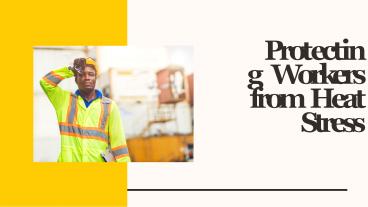hazwoperosha - PowerPoint PPT Presentation
Title:
hazwoperosha
Description:
Heat stress can cause a variety of ailments in construction and HAZWOPER workers. As an employer, you have a responsibility to protect your employees' health against these risks. Check out the document for more details. – PowerPoint PPT presentation
Number of Views:25
Title: hazwoperosha
1
Protecting Workers from Heat Stress
2
What is Heat Stress?
You would have heard people discussing heat
stress now that summer is here. But what
exactly is heat stress and why do people keep on
talking about it?
3
What Factors Contribute to Heat Stress?
- Several factors contribute to heat stress, these
include high air temperatures, high levels of
humidity, direct exposure to the sun when
working in open-to-sky works places, direct
exposure to heat sources such as working in
proximity to open fires, exposure to hot
workplaces, workspaces with no ventilation or
breeze, physical contact with hot objects, and
arduous physical activities.
4
Who is Prone to Experience Heat Stress?
Anyone can experience heat stress and related
heat illnesses. However, according to the CDC,
workers who are overweight, over the age of 65
years, diagnosed with high blood pressure or
heart disease, or take prescription drugs that
may have a negative impact from extreme heat are
those at greater risk
5
Types of Heat-Related Illnesses
Heat Stroke This is the most serious of all the
illnesses that be contracted due to heat stress.
When the body temperature rises rapidly and is
unable to cool down then heatstroke can occur. As
the body temperature can rise to 106 F or
higher within 10 to 15 minutes, heatstroke can
have highly adverse effects on workers health
resulting in permanent disability or, in the
worst-case scenario, death.
6
Types of Heat-Related Illnesses
Heat Exhaustion This is another type of illness,
although it has less severe symptoms and
consequences to good health. Heat exhaustion
occurs when the human body is subject to an
excessive loss of salt and water. This usually
happens when a person sweats excessively and does
not replace the lost fluids. While older workers
and those with high blood pressure are at
greater risk, any workers working in hot and
humid temperatures may suffer from this illness.
Construction workers are a good example.
7
Types of Heat-Related Illnesses
Rhabdomyolysis This is a serious medical
condition linked to heat stress when workers are
exposed to extended periods of physical labor.
Rhabdomyolysis (also known as Rhabdo) occurs
when electrolytes and proteins from damaged
muscles are released into the bloodstream causing
kidney and heart damage leading to other serious
illnesses, permanent disability, and sometimes
death.
8
Types of Heat-Related Illnesses
Sudden Fainting Spells and Dizziness Excessive
exposure to heat can result in workers
experiencing dizziness or fainting spells while
they are standing for long periods or suddenly
stand up. This can occur due to not having
adjusted to the high temperatures, excessive
heat in the work area, or dehydration. Often
referred to as Heat Syncope it is a less serious
form of heat illness and occurs when the blood
flow to the brain is temporarily reduced due to
exposure to very high temperatures.
9
Types of Heat-Related Illnesses
Heat Cramps Perspiration is a very common
occurrence when working in hot conditions. So,
workers in occupations ranging from construction
to roadworks and those working in factories and
small spaces in office complexes can suffer from
excessive sweating. Such workers would be at
risk to heat cramps as they would have lost a
loss of water and salt due to sweating resulting
in their muscles cramping because of the fall in
sodium level in the body. Point to note, heat
cramps are also a symptom of heat exhaustion.
10
Types of Heat-Related Illnesses
Heat Rash Another mild and curable, although very
irritating sickness from heat stress is the
forming of rashes on the skin, especially in
areas such as the inner side of the elbow or
behind the knees. Rashes are developed due to
sweating and humid climate conditions resulting
in blocked sweat ducts trapping the perspiration
under the skin
11
How Should Employers Protect Workers from Heat
Stress?
Employers should also ensure that workers are
given adequate rest periods, are provided with
sheltered and/or cool resting places, have easy
access to cool drinking water, are given rotating
work schedules or have modified working hours
with adequate breaks for rest and drinking
water, are encouraged to self-monitor against
heat stress or have a system where workers keep
tabs on colleagues, and are given use of
protective clothing that provides cooling.
12
How Should Workers Protect Themselves?
As important as it is for employers to offer
adequate protection against heat stress, workers
must also make sure to take care of themselves.
So, employees must adhere to the
following. Comprehend the signs and symptoms of
heat stress. Ensure drinking enough water.
Drinking water every 15 minutes and before you
are thirsty is the experts recommendation.
Monitor this with an alarm if it makes it
easier! Try to work under a shade and avoid
working directly under the sun. Monitor yourself
and also keep an eye on your co-worker.
13
How Should Workers Protect Themselves?
Caffeinated drinks should be avoided, as should
alcoholic beverages. Wear clothing that is
loose-fitting, light-colored, and lightweight. If
you must wear personal protective clothing, take
breaks in a cool area, and ask your employer for
types that are conducive to be used in hot
conditions.
14
Contact US
1-866-429-6742 https//hazwoper-osha.com/
info_at_HAZWOPER-OSHA.com

